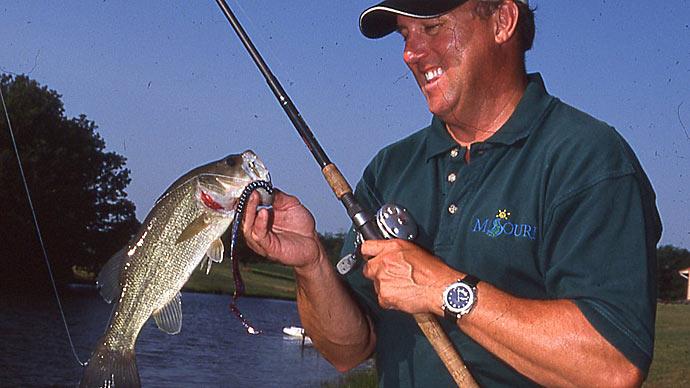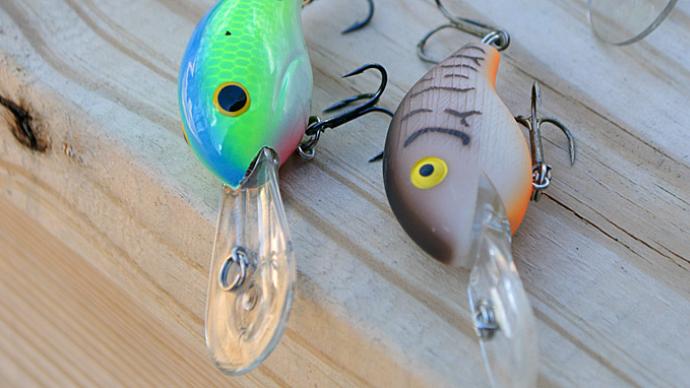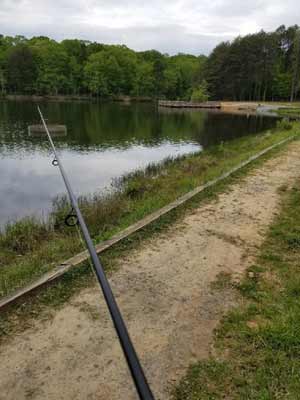
When you’re casting from shore, the bass fishing world seems to work in reverse. You retrieve your lures from deep to shallow, for example, not shallow to deep. While it may seem more complex than fishing from a boat, it doesn’t have to be that way. You can move your fishing forward, catching more and bigger bass, by taking an efficient approach.
Efficiency while fishing on foot isn’t about quantity — how many casts you make per minute or how many spots you hop over the course of the day. It’s about quality — a quiet approach that doesn’t spook bass and casting angles that make lures work for you. But it’s not a one size fits all approach. Each situation you step up to requires something different. Here are the tweaks you should make for the bank-fishing situations that you are most likely to come across.
Shallow water
Bank-bound anglers are shallow water anglers by nature. Without much water over their backs, bass are in tune with their environment. So, you need to be cautious, calculating and stealthy to be successful.
When shallow water is clear and calm, bass can see below and above the surface. So, things happening along the bank are within sight. Quick movements draw attention to yourself, possibly spooking bass that are near the bank. Keep your movements to a minimum. Stand among trees or bushes to mask your presence. Walk slowly, crouching if that helps you go undetected.
Start fishing before you reach the bank. If there aren’t any obstacles between you and the water’s edge, make your first casts from several steps back. You’re not looking to cast far, instead focus on the cover that’s within a rod length or so of shore. Move forward after you’ve fished that.
What you wear can be as noticeable to bass as how you move. Full-on camouflage clothing may be a stretch but wearing drab colors that blend into the background is a good idea. If you’re fishing along a bank lined with trees during the summer, for example, choose light-colored pants or shorts and a dark-colored shirt and hat. Not only does that two-tone approach match the trees behind you, the opposing colors break your silhouette.
Rip-rap
It’s a common occurrence. Anglers fishing from boats, who have the option of going anywhere on a body of water, cast at shore, while bank-bound anglers try to fish as far out as possible. Many times for the latter, the best cover is right at their feet.
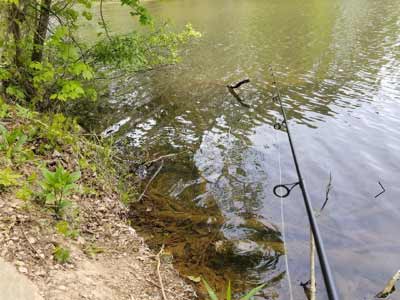
These stretches of strategically situated rocks are used for shoreline security, keeping wind, waves and wakes from eroding soft banks. They commonly are found along roads, bridges and fishing access sites, putting them within easy reach of bank-bound anglers.
Bass love to live around rip-rap for several reasons. In spring, its rocks absorb sunshine, warming the adjacent waters. Its cervices attract baitfish and crawfish, creating an abundant and reliable food supply. And its subtle points and pockets, along with different sized rocks, provide plenty of ambush points for feeding.
Even though anglers and bass like rip-rap, it can’t be fished randomly. Instead, first size up the situation from a distance. These rocks offer plenty of protection, so bass will hold very shallow, even when conditions, such as bright skies, force them from other skinny water situations. You’ll want to fish for these first, staying back so you don’t spook any of them. Look for the pockets and points closest to shore, and don’t forget the ends of the stretch.
After fishing the shallowest spots, work your way farther from shore. The rip-rap isn’t only where water and land meet. It often continues underwater, away from the bank. And here, whether where the rip-rap transitions into the bottom or where a rock or two have rolled away, can be dynamite spots. Finding them takes some work, dragging a Carolina rig or grinding a medium running crankbait. But once they’re located, you can plan better approaches.
Aquatic vegetation
Aquatic vegetation — emergent and submergent — is found along the bank, too. And as the old saying goes, where you find grass, you find bass.
Assess how the vegetation grows. Bass use grass that rings the shoreline differently than matted or submerged beds that trail off into deeper water. If you’re faced with the former, position yourself to make casts along the shoreline. That will keep your lure in constant contact with the cover, passing each point and pocket, where bass are most likely to be lurking. Once you’ve fished a stretch, reverse course. That gives bass a different look at your lure.
Beds of aquatic vegetation are a different animal. While casts along the bank will cover its inside edge — a great place to find bass in spring and fall — fancast your way outward, covering as much of it as you can. Moving lures, such as spinnerbaits, lipless crankbaits and soft jerkbaits, allow you to efficiently cover more of it.
Frogs and toads will cover vegetation that’s matted on the surface without having to deal with snags. Don’t hesitate to pitch Texas-rigged soft-plastic lures into the holes in the vegetation. Avoid those with swimming tails or appendages, which are more likely to hang, ruining retrieves. Instead, lean on straight-tail worms and tubes. Not only do they have to slither their way into the grass, but you have to get them back out. You won’t be right over the top of them, so you will need this advantage to work them back out, too.
Laydowns
Laydowns attract bass like a magnet does iron filings. They offer plenty of cover, from the bank, where roots pulled from the ground can form a hole, to farther out, where branches fill the water column.
From a boat, anglers focus their casts along the trunk of a laydown, working lures across and through branches. But that approach is a lost cause from the bank. Lures will funnel toward where branches meet the trunk, almost guaranteeing a snag every cast. The chances of recovering a snagged lure are low when you’re fishing from the bank. And every one that you break off costs you money and time — from working to unsnag it to re-rigging. You’ll want to step to the side instead, casting to the trunk and working your lure along each branch. That will mean more casts at each laydown, but you’ll leave with more of your lures and more bass.
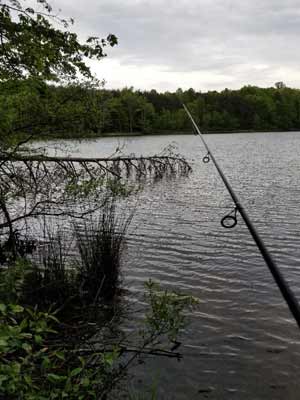
As with the other situations, lure selection is important when fishing laydowns. With so many opportunities to snag, choose ones whose hooks are protected. Frogs and spinnerbaits cut through this cover, catching active bass that are chasing baitfish. If you need to slow down, choose a Texas-rigged soft plastic lure that doesn’t require a weight such as a stick worm. Tapered bullet weights will wedge into crevices in the bark. If you need to add weight, insert a nail weight such as those used with Neko rigs.
Deep water
Deep water is relative to where you are fishing. On some ponds, it may be 3 feet. And if you’re alongside a major river, it could be 25 feet or more. But finding some close to shore is always a bonus no matter when or where you’re fishing.
Bass find protection from changing conditions, predators and fishing pressure in deep water. While they may not always remain in it, having it nearby means a quick escape. So, once you locate one of these spots, return often and take your time fishing it. Deeper water also offers you concealment, allowing you to get closer to the bank without bass detecting you.
Fishing the deep water is a no brainer. But don’t dismiss the edges, where the bottom falls into the depths. Bass use these breaks to enter and leave deep water. They also heard baitfish against them when feeding.
Weather watch
Weather plays a role in fishing, whether you’re standing on a boat or on the shore. It dictates bass behavior, making them more or less active, and determines your approach. You can use it to your advantage while fishing from the bank.
The wind, for example, pushes the microscopic food of baitfish. That’s why you find baitfish on windblown banks and points. And where you find baitfish, you find bass. So, work your way into a position that takes advantage of it. It may pile bass right up at your feet.
Take note of your position in relation to the sun, too. In clear and calm water, your shadow can spook bass, especially those that receive plenty of fishing pressure. Keep the sun in front of you or on your water side if you’re fishing parallel to shore, so your shadow falls on land.


